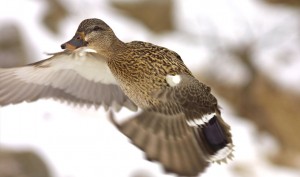Snow and ice in the north have pushed ducks further south but many mallards remain in areas with limited open. From Texas panhandle to Delaware, duck numbers remain below average for this time of year. Goose hunting activity and hunter success has increased dramatically with the snow in the upper third of the nation. Light goose hunting is good to excellent in the north-central states of the coastal flyways with Canada goose hunting in the middle tier of the heartland and central plains good to excellent.
Hello folks, and, as always, welcome to Waterfowler.com.
Winter temperatures finally arrived to many areas of the north over the holidays and ducks and geese pushed a bit further south. Much like the Mayan apocalypse and the Fiscal Cliff crisis, the record migration of 2012 has yet to come to fruition during the open season for many states.
The drought has clearly played a significant role in not only the distribution of waterfowl in northern stats but has also influenced the slower than normal migration as well. Despite the abundance of water in the deep south, ducks in the north that have been forced to use large water impoundments have remained there longer as they freeze later than the shallow marshes. In the absence of extended sub-zero temperatures, rivers in the north have also remained open and waterfowl have been happy use them.
Looking back at our historical reports over the past 15-years of migration reporting, we can emphatically state that peak migration times are occurring later in the season in many areas. Only in the past week, have the mallards that arrived here in northern Illinois after the season had closed, have departed for open water to the south – a trend that has been commonplace in all but one of the past eight years.
Of course, having a conversation about changing duck trends these days is impossible without talking about the weather. Now weather, until this point and time in history, was always a “go to” topic you could discuss with any stranger politely. In today’s climate of conversation, where everything seems everything political, the mere mention of weather and your opinion or observances thereof, is likely to end in a knockdown drag-out brawl of pseudo-politico, mish-mash garbally-gook.
Frankly it’s sad. At some point in the past five-years, political conviction has enveloped itself with the fuel of hate and consumed the time-honored of simply talking about the weather. As Delta Waterfowl Foundation embarks on a study of migration trends as they relate to weather, we wish them the best of luck. As duck hunters, we need the study to help influence the selection of season time frames. If ducks are truly migrating later, we need to know. The relevance of whether ducks are migrating later due to climate change that is normal or influence by carbon emissions has no relevance to the conversation. We’re not asking why they are migration later, just if they are.
As the season progresses and the conversation continues about migration trends, we ask our readers to check their political convictions at the door when thinking about this topic. We encourage you participate in the forums (open to all registered guests) as we ask the question, “Do you think ducks are migrating later, and should state’s begin the studies to adjust season time frames accordingly?”
PACIFIC FLYWAY
Dark goose hunting and numbers are good to excellent from Washington to Wyoming. Duck hunting remains good along the Columbia River basin and typical late season areas in Montana. Duck numbers in northern California remain steady with little weather to move birds to the gun. Ice in Utah has pushed an abundance of birds south. In southern Californian and Nevada duck numbers have increased over the past week with hunter success fair to good until weather arrives to move the birds that are accumulating.
CENTRAL FLYWAY
Ducks remain in substantial numbers along the Missouri River corridor in South Dakota. Canada goose has slowed in Nebraska over previous weeks as extended freezing temperatures have moved birds further south. Duck numbers increased slightly from the Texas Panhandle to the Missouri border over the past week with goose numbers increasing Oklahoma and Kansas. Duck hunting along the Gulf coast remains good to excellent in most areas with numbers steady as migrants replace those that have been harvested or migrated into Mexico.
MISSISSIPPI FLYWAY
Goose hunting remains good to excellent from Iowa to northern Indiana – where a substantial number of mallards are still present. Duck numbers in Missouri are up slightly over last week with mallards fair to good at this time. Pintail numbers are good to excellent in Arkansas with mallard fair and all other early species good. Hunting remains fair to good in Mississippi and Louisiana with gadwall, teal and other early migrators filling the primary bag.
ATLANTIC FLYWAY
Snow accumulation in the north has improved duck hunting from Virginia to New York with mallard and black duck numbers rising. Sea duck hunting has improved in northern costal waters as divers continue to build along the coast. Bluebill numbers have increased substantially in North Carolina with ringed-necked ducks pushing further south into Georgia, Alabama and northern Florida. Canada goose numbers have increased from eastern Pennsylvania to New Jersey with Snow goose numbers average for this time of year.
Until our next report, hunt safe and hunt often.
Photo Credit: (C) 2002 Steve Davis






